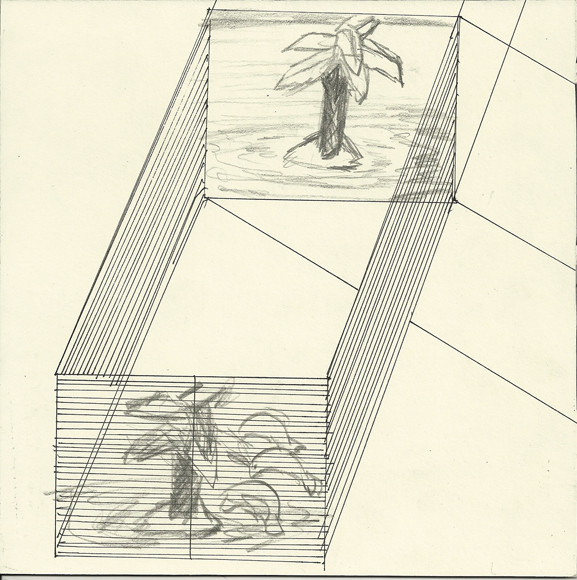Hearing spaces
Ambience and audience

I’m always interested in the physical, digital, and in-between spaces audio recordings document and inhabit. This playlist samples some combinations of various recording environments, paying a bit of attention to often overlooked aspects such as tape hiss and telephone distortion, as well as considering sonic contexts like the classroom and direct-to-digital readings. When I listen to recordings, I’m always calculating my distance from them, from the physicality of the reader’s voice, from the artifacts of recording technology, from the various, multiple sets of imagined audiences and first-run hearers of the poem. In this playlist I’m thinking about space and spatiality in terms of the materiality of the sound recording and as a thematic concern in several of the tracks. This list explores both how one moves through and articulates space and how spatiality is experienced as a listener. Although paying attention to micro-level details risks focusing on the potentially trivial, I think it is worthwhile to consider the sedimentary layers of audience and interference infused within the object of the audio file.
I’ll begin with a recording of Joseph Ceravolo reading at his home in Bloomfield, NJ in Spring of 1968. In the first poem Rain there is a moment of near silence (with a little tape hiss) before the music arrives, then both hiss and music are superimposed with Ceravolo’s voice. I almost hear the word “surrounded” echoed in the background singing voice when Ceravolo reads that word. The music alternates between interference and sympathetic emphasis throughout this entire session, with serendipitous moments constantly emerging and dissipating. The space I imagine when listening to these poems is very private. I don’t picture anyone else in the room, although I could be mistaken. I don’t have much bibliographic context for them, which makes me curious about how they were distributed, how much conscious control Ceravolo exerted over the overlaps between the music and his poems, and what kinds of listeners he imagined once the recording was created. Compare the atmosphere of this recording with a live reading ten years later at the Ear Inn. Ceravolo’s introductory comments and his quick, energetic reading of poems such as Lightning stand in stark contrast to the earlier home recording in the way they emphasize his relationship to a particular New York poetry scene in the late 1970’s.
Lisa Robertson reads and discusses several pieces from her book Occasional Work and Seven Walks from the Office for Soft Architecture on Episode #204 of Leonard Schwartz’s radio show Cross-Cultural Poetics, which is archived on PennSound. Listen to Robertson read Spatial Synthetics: A Theory. In Robertson’s conversation with Schwartz following the reading of that piece, she discusses some of her own theories of how ideas of space and the body function in this work: “I wanted to make sure that my theory of space was non-abstract and rooted in bodily pleasure.” In addition to the engaging content of the piece itself, I was especially interested in the intricacies of the sonic environment in that it was broadcast on radio, with Robertson reading over the phone, and Schwartz responding from the studio space, then later distributed as a sound file on PennSound. Because of the dialogic nature of Schwartz’s show and all the subtle layers of mediation, I found myself occasionally listening to Schwartz’s listening to Robertson, hearing subtle responses in his breathing or an occasional, barely audible laugh in other parts of the broadcast. I found myself paying attention to the contrast in textures between Robertson’s phone reading here and, say, this reading of her poem Lucite (from her book Lisa Robertson’s Magenta Soul Whip) at the POG series in Tucson. By the way, there’s an excellent review of the book, focusing on this particular poem, by Emily Critchley on How2.
Farid Matuk’s poem An American in Dallas was recorded specifically for Jacket2, at his home in Texas. This type of recording (one that begins in a somewhat similar space to Ceravolo’s but was consciously created for digital listening) is fairly rare in the PennSound Archive. I find that kind of space really charged with an exciting kind of intimacy, rather than feeling spatial neutrality, or non-located in space. I like knowing that this poem was recorded in proximity to some of the people and places mentioned by name. In this context, lines like: “Where should my perception sit/to be marked present?” take on new resonances. In many ways the poem is rooted in a particular landscape, but the consciousness of the speaker is always moving around, switching vantage points, moving through a series of minute sensory impressions and social spaces.
Bernadette Mayer’s 1978 class discussing her book Memory , from the Naropa audio archives, is a fascinating listen for a number of reasons. It’s an incredible document of Mayer talking about the processes and thinking behind some of her most ambitious projects. I’ve listened to it several times primarily paying attention to the ideas and lively exchanges, but in the background there’s a barely audible soundscape of something that seems like singing or chanting. In the talk, Mayer says (about her piece Memory): “I was still trying to get myself away from the printed book. I was trying to figure out a way-- I mean where is that space? Where should the reader be?” There is an impulse in much of Mayer’s work to try to let in as much sensory data as possible, to enlarge and amplify what registers as significant. I’d like to bring this kind of attention to the digital audio file, which I’ll be picking up again periodically in later posts.
Notes on PennSound